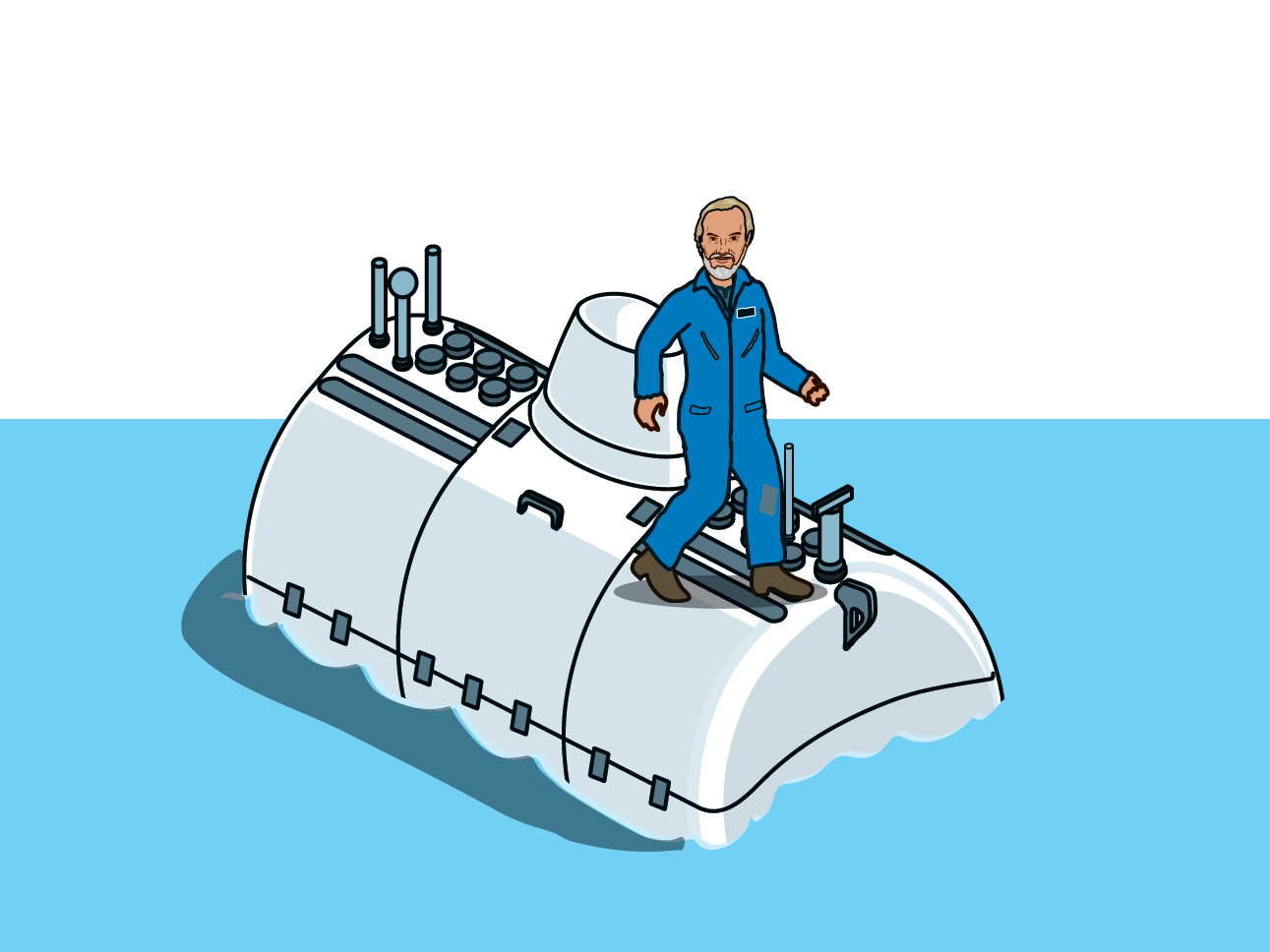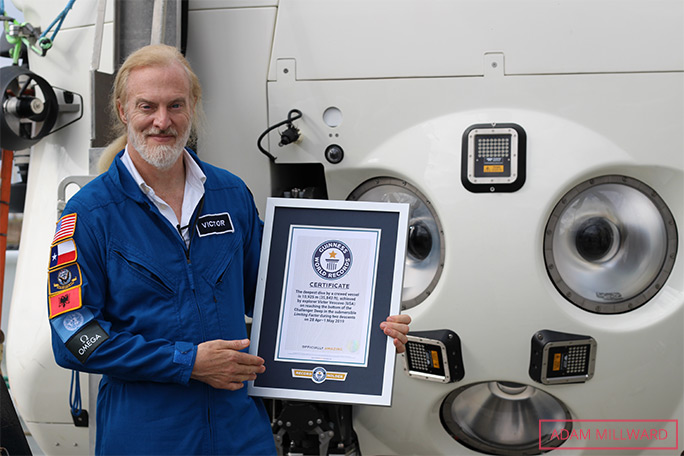
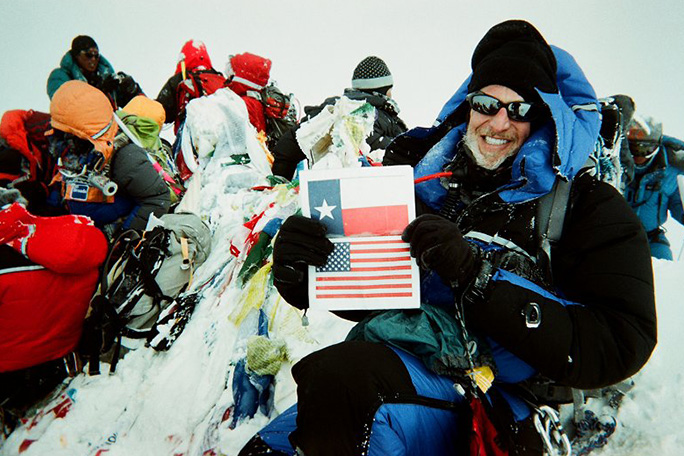
Proud Texan Victor waves his state flag on the summit of Everest
Humans first conquered Mount Everest (the highest point on Earth) in 1953 and the Challenger Deep (the deepest point on Earth) seven years later. But no single person had ever visited both until Victor Vescovo (USA) plunged to new depths in 2019…
For most people, climbing a mountain would be the pinnacle of their adventuring lives. But for retired US Navy officer-turned private equity investor Victor Vescovo, striking “climb a mountain” off his bucket list was never going to be the end of the story.


Proud Texan Victor waves his state flag on the summit of Everest
In 2017, Victor became one of only 70 people in history to have completed the Explorers’ Grand Slam. This achievement, much lauded in the extreme adventure community, involves scaling the highest peak on each continent (aka the “Seven Summits”) and travelling to the North and South Pole.
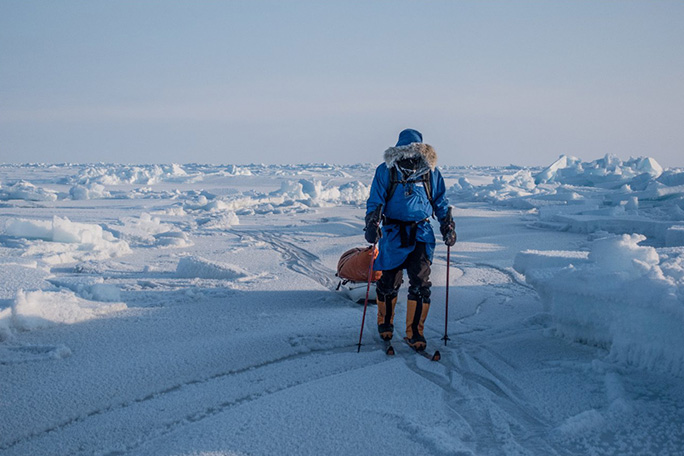
Victor during his trek to the North Pole
Victor is one of the 49 of those to have completed a “Last Degree” Grand Slam, which involves skiing at least 100 km (60 mi) – i.e., from 89° to 90° – to the poles.
(The remaining 21 members of the Explorer’s Grand Slam club made their way to the poles from coastal starting points, covering much greater distances with supply-laden sledges, and are thus widely treated as a distinct category.)
Soaring to 8,848 m (29,029 ft) above sea level, Everest (aka Sāgārmatha or Chomolungma) is the world’s highest mountain.
The first ascent of Everest was made by New Zealand’s Sir Edmund Hillary and Tenzing Norgay (Tibet/India) on 29 May 1953, with the help of a large expedition team headed by military man Henry Cecil Hunt (UK). Five days shy of 57 years later, Victor followed in Hillary and Norgay’s footsteps. He was in the best of hands, for guiding him to the top was none other than fellow GWR Hall of Fame inductee, Kami Rita Sherpa (NPL), who has completed the most ascents of Everest (24 as of 2019).
“Everest is physically punishing,” Victor told us straight. “It’s cold, you have trouble breathing. It’s a very raw, visceral experience but gosh the view. It’s a great allegory for life, climbing a mountain like that. You start off all optimistic and excited, and then it beats the hell out of you, and you just have to pick yourself up and keep moving to achieve an objective… And maybe you don’t even get it – but you can come back. It’s all about how resilient you are as a person.”
Of course, once Victor had scaled all the highest points on Earth, it was only natural that he would stop looking skywards and set his sights lower… much lower.
Which is how the Five Deeps Expedition – a never-before-attempted enterprise to visit the deepest known point in each of Earth’s five oceans – was conceived in 2015.
While the idea was an off-the-charts level of intrepid, worthy of a Jules Verne novel, it wasn’t a case of simply heading out to sea and diving in… This raw ambition had to be backed up by rigorous planning, huge investment and a whole new paradigm of explorative technology. Working with Triton Submarines, Victor spent over four years developing a brand-new deep-sea submersible that would be up to this immense task.
It needed to be capable of multiple descents into parts of the ocean where pressure levels can reach in excess of 1,000 times that at the surface.
The result was DSV Limiting Factor – arguably the most advanced deep-sea crewed vessel in the world right now.
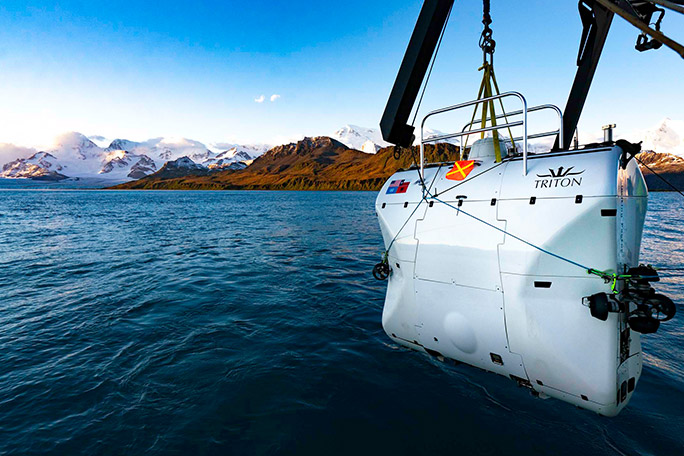
The deep-sea submersible Limiting Factor that Victor piloted to the oceans' deepest points
A submersible alone wasn’t going to cut it, though. Victor also acquired what was ironically in a former life during the Cold War a US Navy submarine hunter, transforming it into a state-of-the-art research vessel named Pressure Drop. Victor knew from the start that he not only needed the best technology but also the best people, so his expedition boasted a wealth of talent plucked from all around the world. These included specialists in everything from geology and marine biology to sonar mapping – the latter of which were initially tasked with pinpointing exactly where the deepest points were located! These technical experts were augmented by a veteran crew with profound maritime experience who would be more than capable of dealing with anything that Neptune could throw at them.
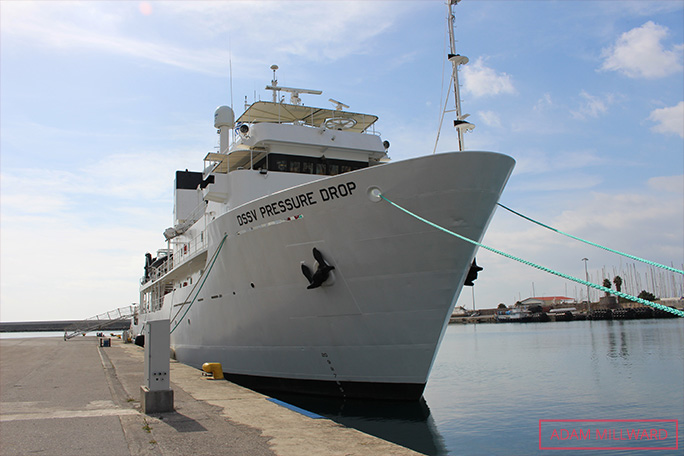
Vescovo's state-of-the-art research vessel, Pressure Drop, moored in Kalamata, Greece, in early 2020
The first dive on the roster was the Puerto Rico Trench (home to the deepest point in the Atlantic Ocean), which was completed without a hitch on 19 Dec 2018. The project was brought to a close on 24 Aug 2019, just 10 months later, with a descent to the Molloy Deep in the Arctic Ocean. Both of these dives were milestones in their own right as neither had been visited by a human-piloted vessel previously. In 2020, Victor was awarded the Explorers Club Medal - the highest accolade given out by the organization in recognition of all that he has achieved across all of the planet's most extreme locations.
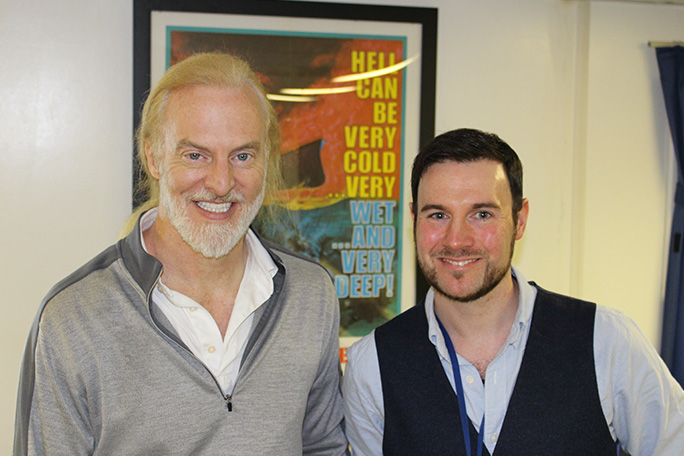
Guinness World Records' Managing Editor, Adam Millward, was given a tour of the ship (the mess of which boasts a lot of maritime-themed movie posters!)
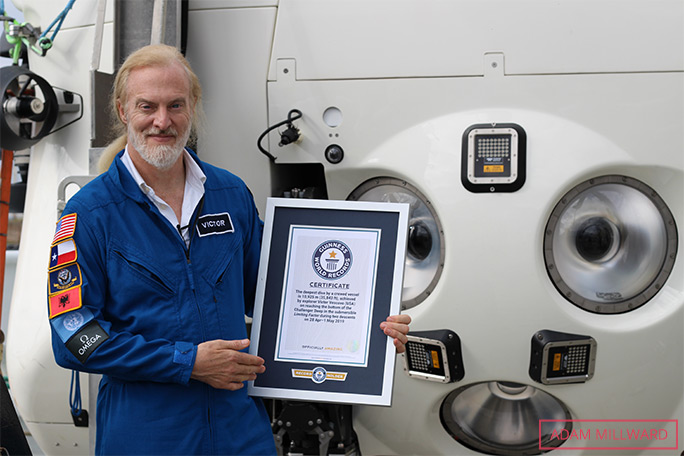
Victor beside the Limiting Factor sub, holding one of his Guinness World Records certificates and the latest book in which he features
Five Deeps Expedition: the deepest points in the oceans
| Ocean | Deepest point location | Date dived | Depth |
| Atlantic | Puerto Rico Trench | 19/12/2018 | 8,376 m (27,480 ft) |
| Southern | South Sandwich Trench | 3/2/2019 | 7,434 m (24,390 ft) |
| Indian | Java Trench | 5/4/2019 | 7,192 m (23,596 ft) |
| Pacific | Challenger Deep (Mariana Trench) | 28/4/2019 | 10,925 m (35,843 ft)* |
| Arctic | Molloy Deep | 24/8/2019 | 5,551 m (18,212 ft) |
*since updated in 2020 to 10,934 m (35,872 ft) +/- 3 m
The technical challenges presented by the dives aside, the logistics behind the Five Deeps Expedition were equally gruelling. Victor revealed: “We had to slot the dives in to fit with the weather conditions in each ocean. We went through 94 iterations of our schedule! This was because of weather issues, mechanical issues or permit issues
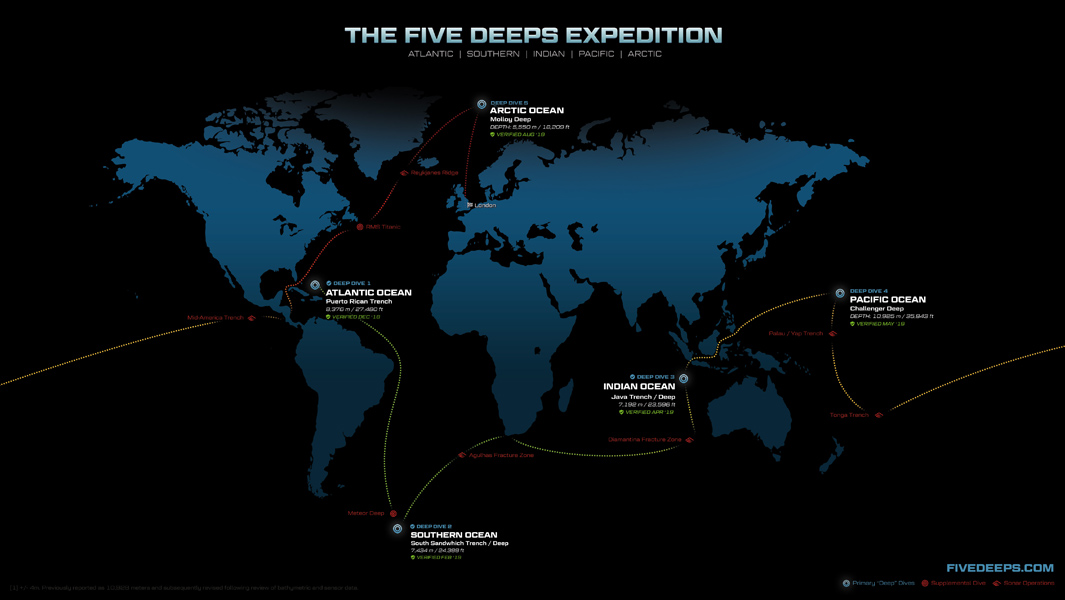
A map of the Five Deeps Expedition showing the deepest points in the five oceans
While all five dives yielded unprecedented scientific discoveries (including potentially 30 to 40 new species), it was arguably the fourth stop on the mission that really shook things up: the Challenger Deep, which at nearly 11 km (6.8 mi) beneath the surface is not just the deepest point in the Pacific Ocean, but also the deepest point on Earth.

These findings were corroborated by a second expedition led by Victor in June 2020, during which he was joined by a number of passengers, including Dr Kathy Sullivan (USA), over a series of dives. This ocean scientist, NASA astronaut and former head of the National Oceanic and Atmospheric Administration (NOAA) has now become the first woman to visit the Challenger Deep (as well as the first person to travel to space and the Challenger Deep).
This means that Earth’s deepest point has now been confirmed to be even deeper than we previously thought. The raw data collected across the latest series of dives has now been rigorously analysed by independent hydrographic experts and they have determined a maximum depth of 10,934 m (35,872 ft), give or take 3 m (at 1-sigma/68% probability) or 6 m (at 2-sigma/95%); in either case, it's a new depth record for the Challenger Deep.
To give a sense of just how deep it is, refer to the Burj Khalifa in Dubai, UAE.
At 828 m (2,716 ft), this is the world’s tallest building and also inducted to the GWR Hall of Fame. Now imagine a stack of 13 Burj Khalifas, one atop another; even this vertiginous mega-building would still not quite break the surface if it was placed on the sandy seabed of the Challenger Deep. For more “diminutive” man-made structures, that equates to 28.5 Empire State Buildings, 36 Eiffel Towers or 78.5 Great Pyramids of Giza!
Across two dives that Victor conducted in 2019 into what is referred to as the “Eastern Pool” – a depression within the Challenger Deep, which itself is a depression in the much larger Mariana Trench – both direct observations and instrumental readings indicate that the seabed there was not as flat as previously thought. Rather, maps of the seafloor, created with data collected by multiple CTD (conductivity, temperature, depth) sensors on the submarine and three robotic landers reveal subtle bumps and ridges.
The average depth from these two descents was calculated to be 10,925 m (35,843 ft).
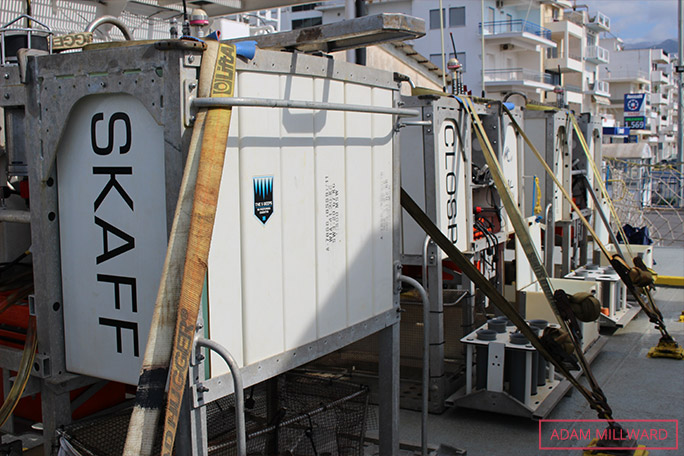
Skaff, one of the robotic landers on the Five Deeps Expedition, all of which were named after self-aware drones in the Culture sci-fi series by author Iain Banks
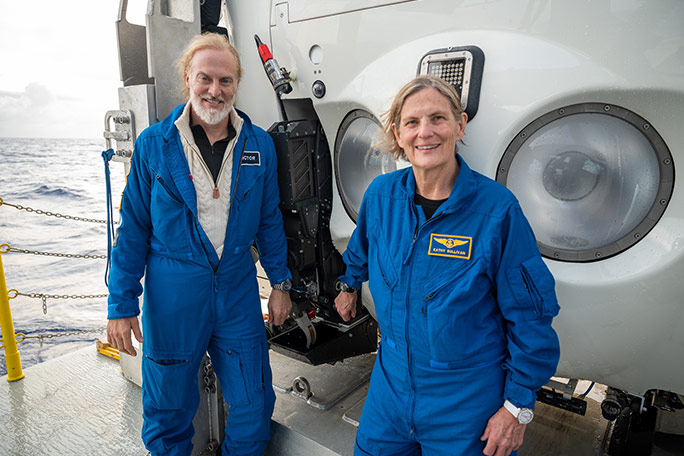
Victor with oceanographer and astronaut Dr Kathy Sullivan, the first woman to visit the Challenger Deep
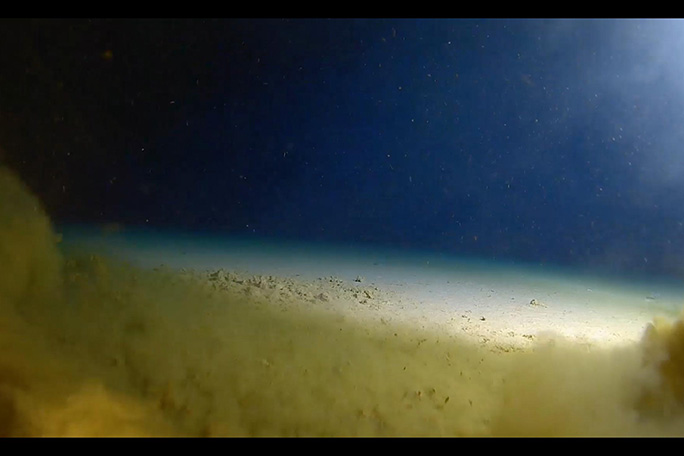
Touchdown at the bottom of the Challenger Deep in the Mariana Trench
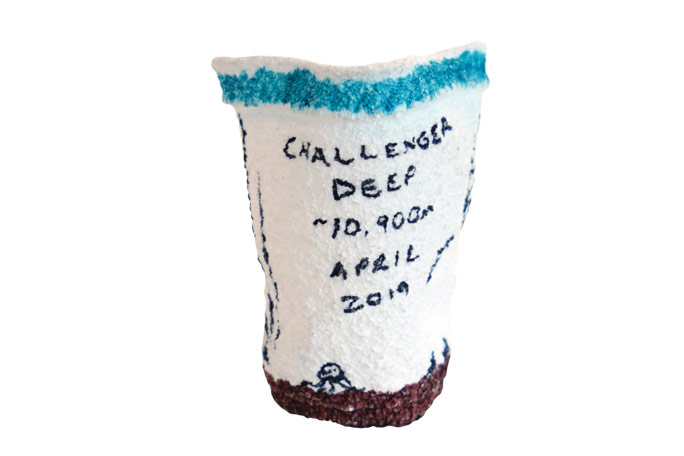
A polystyrene cup crushed to the size of a shot glass by the immense pressure during the descent to Challenger Deep
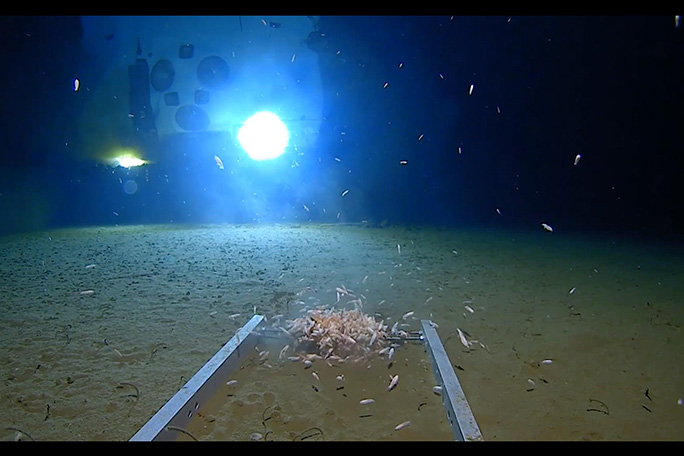
The Five Deeps Expedition was an opportunity to study many new species
Victor has now made a total of eight dives into the Challenger Deep, more than any other individual. Indeed, of the 13 aquanauts that have taken the ultimate plunge to date (just one more than astronauts to have walked on the Moon), he is one of only two to have done so more than once.
While he may now be an “old hand” at it, we asked him to tell us how it felt the very first time: “I’d done a lot of dives by that point, but with the Mariana Trench, you know it’s going deeper than ever before. In the back of your mind, you’re thinking ‘I’m pretty sure everything’s going to work perfectly and I’m going to come back safely’ but you don’t know until you do it.
"You can psychologically feel the 16,000 lb/sq in that’s just outside the windows, which is literally compressing the submarine almost a quarter of an inch as you go down."
“But you get down to the bottom, and then it’s really exciting. You’re driving around looking for wildlife and exploring the bottom. It was amazing. I was down there by myself in a custom-built titanium submarine at the bottom of the ocean and… I could do whatever I wanted – I felt like I was five years old again!”
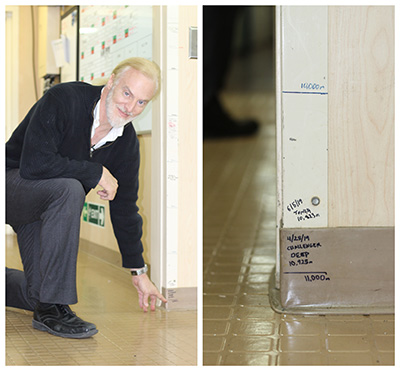
Victor marks off his dives on the door frame of the command centre on board the ship; not surprisingly, the Challenger Deep is found right at the bottom near the floor
On his first descent, Victor spent a total of four hours at the Challenger Deep – longer than anyone had ever spent there – and not a moment was wasted. “The key thing is to video as much as possible,” he explained. “The scientists were adamant in telling me, you should just cover as much ground as you can.
“We did that to film the wildlife but also to film the contours of the [seabed] and just see what was there. Eventually we moved to the edges where it started to slope upwards and then we got to see rocks. The geologists were really fascinated by what colour they were, whether they were igneous or sedimentary… It was all about collecting science.”
While a lot of important work was being done, Victor made sure to find a few moments to kick back and enjoy the experience. “I let the sub drift and ate my lunch,” he told us. And what do you eat at the deepest part of the ocean? Apparently on the menu was “A tuna sandwich and some chips [crisps].”
I was in the military for 20 years and there was a saying: ‘No plan survives contact with the enemy’. And it’s the same with this: ‘No plan survives contact with the real world’. It’s all about being able to adapt.
Not all that Victor saw was so positive, though, as he encountered some litter even at these extreme depths. “I was navigating around the bottom of the Mariana Trench and I saw out the corner of my eye some sharp edges, and nature doesn’t do that. I cruised the submarine over there and sure enough there was what looked like might have been cloth or plastic. It was a bit of a gut-kick. It was made even worse when I saw a small sea cucumber on it, perhaps thinking it was food.”
Victor is the first person to reach Earth’s highest and lowest points, but the first people to reach the Challenger Deep made the dive almost six decades before him. Fellow US Navy officer Captain Don Walsh (who was a guest on the Five Deeps Expedition) and Jacques Piccard (Switzerland, 1922–2008) made the descent on 23 Jan 1960 in the bathyscaphe Trieste. It took almost five hours for the vessel to reach the seafloor, and they only had about 20 min at the bottom before they had to return to the surface, but that was more than enough for their feat to “go down” in history. Walsh and Piccard logged a depth of 10,912 m (35,800 ft).
The first solo descent to the Challenger Deep, meanwhile, took place on 25 Mar 2012 in the submarine DEEPSEA CHALLENGER. At the helm was Canadian film director James Cameron, in a project backed by National Geographic and Rolex. The final depth reported from that expedition was 10,908 m (35,787 ft).
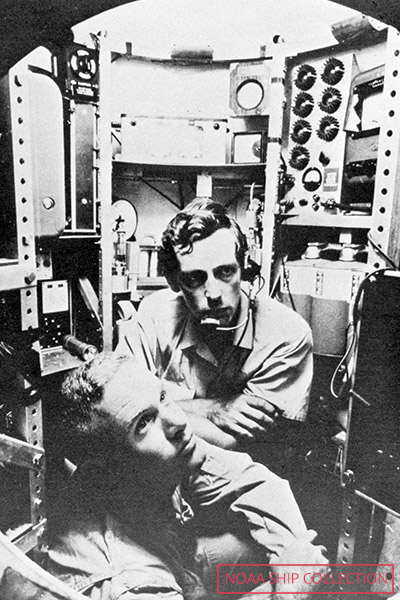
Jacques Piccard and Don Walsh became the first people to visit the deepest point in the ocean in 1960
Victor’s deep-sea exploits have opened up a new chapter in the history of exploring the Challenger Deep. Because his Limiting Factor submersible is designed for multiple trips and can accommodate two people, he has been able to pilot several others to the bottom of the world. Some of these passengers have been mainly there for the science, others for the adventure. But in either case, it has led to several more record-setting milestones, and it’s likely there will be more to come. So what’s next for an explorer who has done this much? Is there any limit to what Victor will take on? “I hope not,” he said, with a trademark glint in his eye. “I hope to stick around long enough to keep doing these challenges. “I’d love to go to space. No one’s been to the top of the world, the bottom of the world and to space so I’m talking to some guys about that…
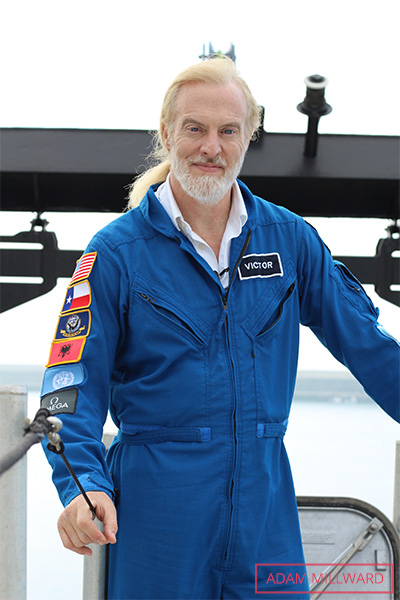
“I think that’s what we’re here for. Everyone has things in their lives which are challenges, whether they’re personal or professional or they’re things like this where you’re going into the wild and doing something extraordinary.
“If there’s one thing I’ve seen in my own life, it’s that people sell themselves short too often. People are capable of much, much more than they think they are. They just have to push themselves.”
